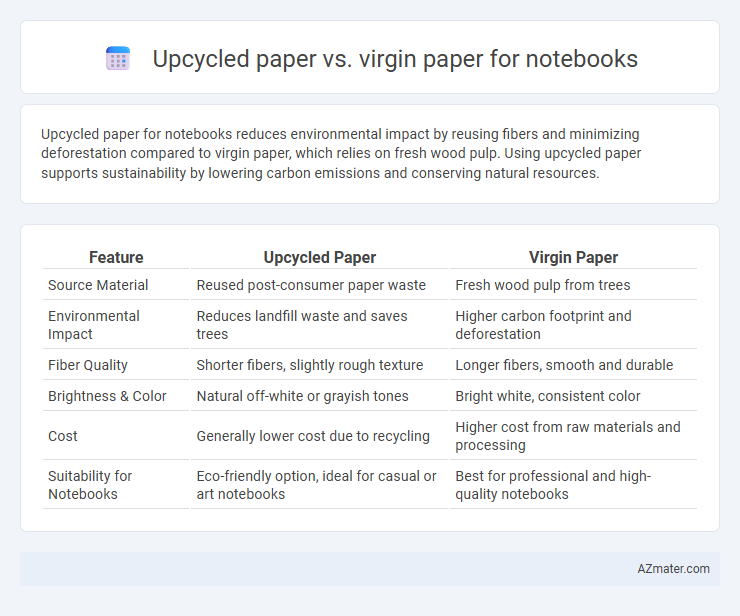Upcycled paper for notebooks reduces environmental impact by reusing fibers and minimizing deforestation compared to virgin paper, which relies on fresh wood pulp. Using upcycled paper supports sustainability by lowering carbon emissions and conserving natural resources.
Table of Comparison
| Feature | Upcycled Paper | Virgin Paper |
|---|---|---|
| Source Material | Reused post-consumer paper waste | Fresh wood pulp from trees |
| Environmental Impact | Reduces landfill waste and saves trees | Higher carbon footprint and deforestation |
| Fiber Quality | Shorter fibers, slightly rough texture | Longer fibers, smooth and durable |
| Brightness & Color | Natural off-white or grayish tones | Bright white, consistent color |
| Cost | Generally lower cost due to recycling | Higher cost from raw materials and processing |
| Suitability for Notebooks | Eco-friendly option, ideal for casual or art notebooks | Best for professional and high-quality notebooks |
Introduction to Upcycled and Virgin Paper
Upcycled paper is made from recycled materials, reducing environmental impact by reusing existing fibers and minimizing waste. Virgin paper is produced from newly harvested wood pulp, offering higher quality and durability but contributing to deforestation and greater resource consumption. Choosing upcycled paper for notebooks supports sustainability while virgin paper ensures premium texture and strength.
Environmental Impact: Upcycled vs Virgin Paper
Upcycled paper significantly reduces environmental impact by minimizing waste and lowering energy consumption compared to virgin paper, which requires extensive logging and chemical processing. The production of upcycled paper emits fewer greenhouse gases and conserves natural resources, contributing to biodiversity preservation and reduced deforestation. Choosing upcycled paper for notebooks supports sustainability efforts by promoting circular economy practices and reducing landfill contributions.
Resource Consumption and Sustainability
Upcycled paper for notebooks significantly reduces resource consumption by reusing existing paper fibers, leading to lower water and energy usage compared to virgin paper production, which requires fresh timber harvesting and extensive chemical processing. The sustainability of upcycled paper is enhanced through decreased deforestation rates and reduced greenhouse gas emissions, supporting circular economy principles. Virgin paper production, while sometimes necessary for certain quality standards, has a higher environmental footprint due to intensive resource extraction and habitat disruption.
Production Process Differences
Upcycled paper for notebooks is made by recycling existing paper products, reducing raw material consumption and energy use during production, whereas virgin paper is manufactured from fresh wood pulp requiring extensive logging and chemical treatments. The production process of upcycled paper involves breaking down used paper fibers and reforming them, which emits fewer greenhouse gases compared to the virgin paper's pulping and bleaching stages. These differences significantly impact environmental footprints, with upcycled paper promoting sustainability through resource conservation and waste reduction.
Quality and Performance in Notebooks
Upcycled paper notebooks often feature fibers that have been recycled, resulting in slightly lower tensile strength and occasional textural inconsistencies compared to virgin paper, which is known for its smooth surface and uniformity. Virgin paper notebooks typically provide superior ink absorption and reduced bleed-through, enhancing writing clarity and durability over time. While upcycled paper supports environmental sustainability, virgin paper remains the preferred choice for high-quality notebooks requiring optimal writing performance and long-lasting pages.
Cost Comparison and Market Availability
Upcycled paper notebooks generally offer a lower production cost compared to virgin paper due to reduced raw material expenses and energy consumption during manufacturing. Virgin paper remains more widely available and dominates the market, benefiting from established supply chains and consistent quality standards. Cost savings from upcycled paper are increasingly favored by eco-conscious consumers, yet market availability is still limited relative to virgin paper, influencing purchasing decisions.
Aesthetic and Texture Variations
Upcycled paper notebooks exhibit a unique, textured surface with subtle color variations and occasional fiber inclusions, providing an artisanal and eco-friendly aesthetic appeal. Virgin paper notebooks often feature a smoother, more uniform texture and consistent color, delivering a clean and polished look ideal for professional settings. The tactile difference between the rougher, more organic feel of upcycled paper and the sleek, refined finish of virgin paper influences user preference based on desired notebook appearance and touch.
Consumer Preferences and Trends
Consumer preferences increasingly favor upcycled paper notebooks due to rising environmental awareness and sustainable consumption trends. Upcycled paper offers eco-friendly benefits by reducing waste and conserving resources compared to virgin paper, which is derived from freshly cut trees and has a higher carbon footprint. Market analysis shows a growing demand for notebooks made from recycled materials, driven by millennials and Gen Z prioritizing ethical and green products in their purchasing decisions.
Challenges in Adopting Upcycled Paper
Challenges in adopting upcycled paper for notebooks include inconsistent fiber quality, which can affect durability and print clarity, limiting its appeal for high-end stationery. The supply chain for upcycled paper is often fragmented, leading to higher production costs and difficulties in scaling up to meet large orders. Consumer perception and lack of widespread awareness also hinder market penetration, as many buyers remain skeptical about the environmental impact and quality of recycled paper products.
Conclusion: Choosing the Right Paper for Notebooks
Upcycled paper offers environmental benefits by reducing waste and conserving natural resources, making it ideal for eco-conscious notebook users. Virgin paper provides superior durability and higher quality texture, preferred for professional or archival purposes. Selecting the right paper depends on balancing sustainability goals with specific needs for strength and appearance in notebooks.

Infographic: Upcycled paper vs Virgin paper for Notebook
 azmater.com
azmater.com